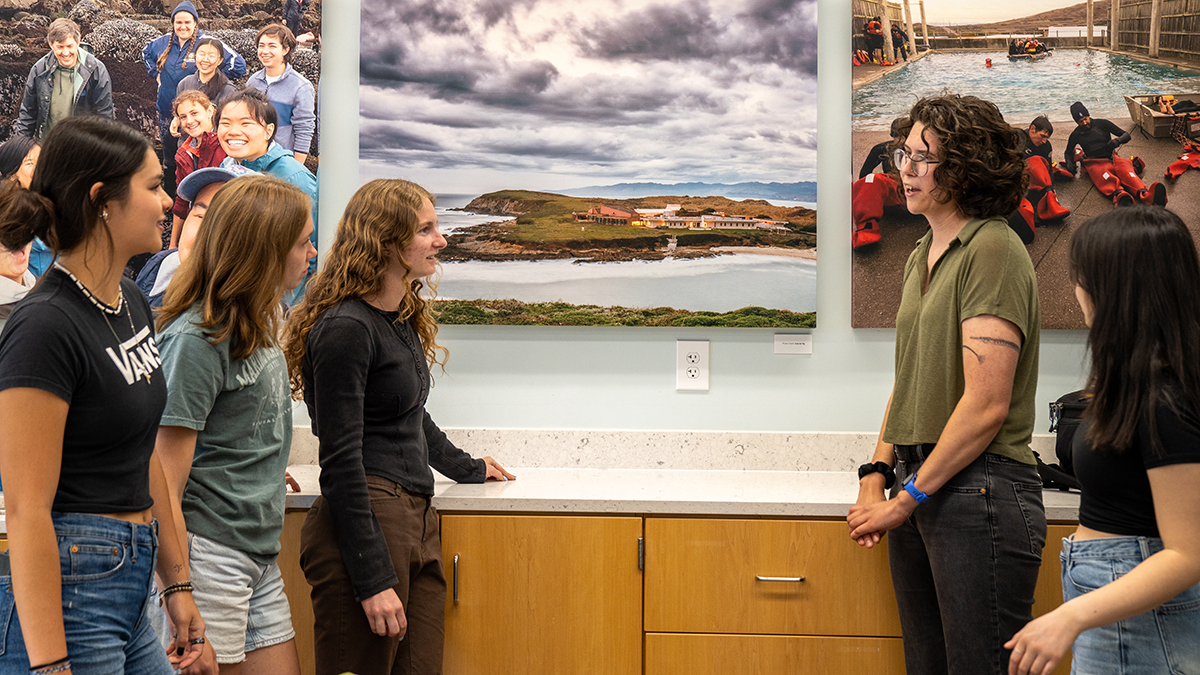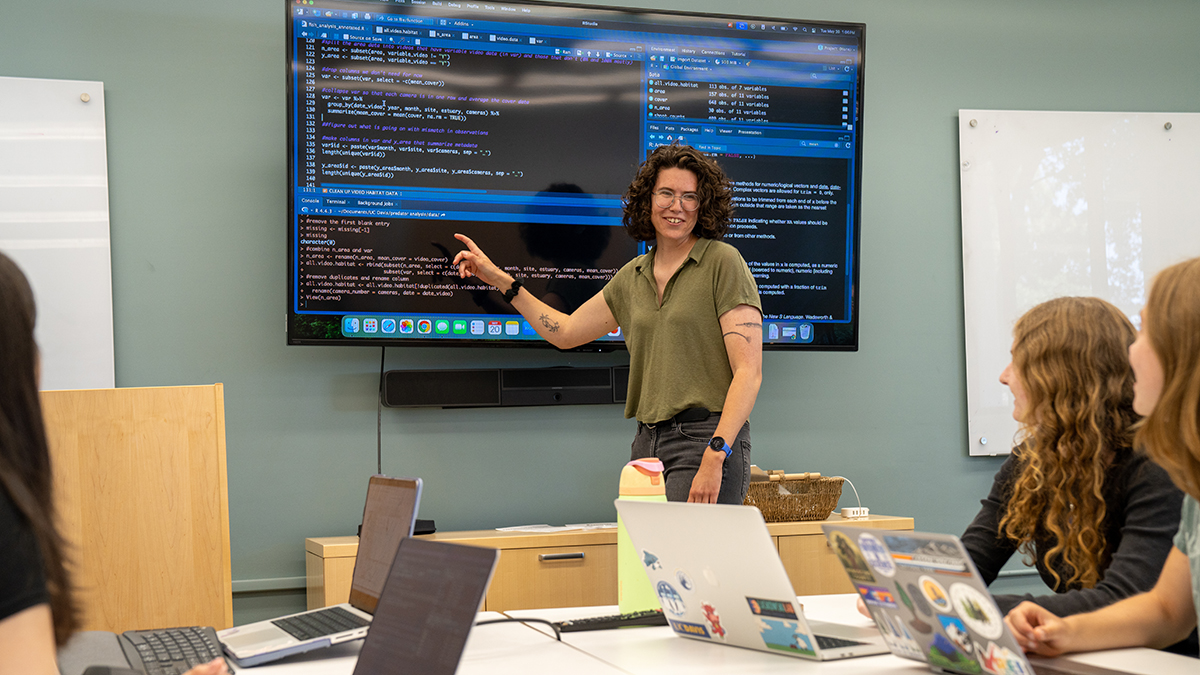
Championing Mentorship Through Marine Research: Claire Murphy Receives Top CBS Graduate Award
Claire Murphy, a fifth-year Ph.D. candidate in the Population Biology Graduate Group, wants everyone to feel like they belong in research. Based at the Bodega Marine Laboratory (BML), Murphy studies how tiny seagrass crustaceans avoid being eaten by fish, crabs, and other predators. Since coming to UC Davis in 2020, she’s mentored 11 UC Davis undergraduates, including five independent summer research projects.
In recognition of her outstanding commitment to undergraduate mentorship, Murphy has been awarded the 2025 CBS Dean’s Mentorship Award. The annual award is funded by philanthropic contributions to the CBS Dean’s Circle and comes with $5000 of research funding, including $2,500 to support the research of undergraduate mentees.
“Claire has a real knack for striking the right balance between encouragement, assistance, and tough-love to help each student reach their potential and grow from the experience,” said Jay Stachowicz, a professor in the Department of Evolution and Ecology and Murphy’s Ph.D. adviser. “Though I had already planned to nominate Claire for this award, other graduate students approached me to ask that I consider nominating her, showing how well-respected she is by her peers for her mentoring efforts.”
Stumbling into seagrass science
Murphy, who grew up in Virginia, has always been fascinated by “bugs.” She discovered research — and a fascination for seagrass ecology — while completing her undergraduate degree at the College of William and Mary.
“When I went to college, I wasn't sure what exactly I wanted to do, but I took a field class on the eastern shore of Virginia in the summer of my first year and it was the best thing I'd ever done,” said Murphy. “I was so impressed by how the TAs and professors knew so much about the life in the area around them. Before that, I didn't realize that natural history was something that you could do professionally.”
After the field course, Murphy signed up as a research assistant in a seagrass lab where she helped count crustaceans in 15-years-worth of water samples from Chesapeake Bay. These experiences helped her realize both her passion for research and the importance of good mentorship.
“I was amazed by how many different species there were, and they were all just from the Chesapeake Bay,” said Murphy. “Every time I went to the field and got to work with the team, it was amazing, but a lot of it was just me sitting alone counting things. I don't want people to sort of have to sit alone in a room and look at things by themselves forever, so now that I’m a mentor, I try to meet with people pretty regularly.”

Making mentoring a priority
“There were two things I really wanted to do in grad school: in-depth fieldwork, and work with students,” said Murphy. “When I interviewed at Davis, I asked my advisor if I could work with undergrads. That was one of the selling points for me in coming here.”
In her approach to mentoring, Murphy prioritizes communication, community, and meeting students where they’re at.
“I’ve worked with lots of students, and they’ve all been great, but it’s fun to see how everyone has different strengths and needs,” said Murphy. “I try to give space for everyone to make observations and have their own curiosity, I just want everyone to feel like they have good ideas that are worth sharing, and that they belong.”
In addition to UC Davis undergraduates, Murphy has mentored students through the Santa Rosa Junior College-BML Internship Program, an annual summer internship program that places students from Santa Rosa Junior College with research mentors at BML. She also co-directed the internship program in 2023 and 2024 and worked to revamp its professional development component.
“Not all the interns are going to become scientists, or even want to be scientists, but we wanted to give them tools to think about how the skills they learn at BML could transfer to other jobs and opportunities,” said Murphy. “Even if you don't want to do science, you learn a lot by asking questions, sharing your ideas, and working with other people.”
Murphy captured almost 300 hours of video footage from seagrass beds during different seasons and counted over 5,000 individual predators, including ducks and various types of fish. Claire Murphy/UC Davis
Staying alive: how tiny crustaceans avoid being eaten
Murphy studies how crustaceans called amphipods and isopods avoid being eaten. She does most of her fieldwork in seagrass beds in Tomales Bay and Bodega Harbor. Many different species of crustaceans live in these seagrass beds, and Murphy has found that they use a variety of strategies to avoid predation. For example, the tiny amphipod Ampithoe lacertosa, secretes a sort of silk that it uses to build tube-like shelters, whereas the much larger isopod Pentidotea resecata relies on camouflage.
“They'll move around and find a blade of seagrass that is the same exact width as them,” said Murphy. “They're the same color as the seagrass, so it’s a really good camouflage strategy.”
At low tide — which could be at 2 AM, 12 PM, or anytime in-between — Murphy wades through thick mud to collect crustaceans, set up experiments, and install GoPro cameras.
With her camera footage, Murphy is investigating how seasonality and the amount of seagrass impact the presence of different types of predators in the area. Altogether, she’s captured almost 300 hours of video footage which she’s just finished watching with the help of a team of undergraduates.
“I have a bunch of wonderful undergrads who have rotated through and helped me watch literally hours and hours of fish videos,” said Murphy. “We've counted 5,000 predators, but we've only just finished watching all the videos, so I don't have much information yet about what patterns there are, but that's the next step.”
Murphy has one year remaining at UC Davis. When she graduates, she hopes to continue to pursue scientific research and mentoring.
“I can't imagine a career where I'm just doing research and sitting behind a computer — the human aspect is so important,” said Murphy. “Working collectively with students has been one of my favorite parts of grad school, and it's something I want to keep doing.”

Media Resources
- Liana Wait is a freelance science writer based in Philadelphia. She has a Ph.D. in ecology and evolutionary biology and specializes in writing about the life sciences.
